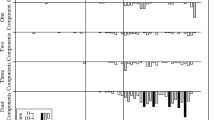Abstract
Despite recent controversy about the status and goals of applied behavior analysis research (e.g., Azrin, 1977; Baer, 1981; Deitz, 1978; Hayes, Rincover, & Solnick, 1980), most researchers hope that applied behavioral research might prove directly or indirectly applicable to the prevention and/or remediation of human problems. Thus, there is at least some expectation that research findings or conceptual understandings derived from that research will be applicable beyond the subjects, settings, and behaviors of the original research. The purpose of this article is to discuss some factors that may limit effective application of applied behavior analysis research and to suggest how these limitations might be overcome.
Access this chapter
Tax calculation will be finalised at checkout
Purchases are for personal use only
Preview
Unable to display preview. Download preview PDF.
Similar content being viewed by others
References
Azrin, N. H. (1977). A strategy for applied research: Learning based but outcome oriented. American Psychologist, 32, 140–149.
Baer, D. M. (1981). A flight of behavior analysis. The Behavior Analyst, 4, 85–91.
Baer, D. M., Wolf, M. M., & Risley, T. R. (1968). Some current dimensions of applied behavior analysis. Journal of Applied Behavior Analysis, 1, 91–97.
Budd, K. S., Green, D. R., & Baer, D. M. (1976). An analysis of multiple misplaced parental contingencies. Journal of Applied Behavior Analysis, 9, 59–470.
Catania, A. C. (1966). Concurrent operants. In W. K. Honig (Ed.), Operant behavior: Areas of research and application. (pp. 213–270). New York: Appleton-Century-Crofts.
Deitz, S. M. (1978). Current status of applied behavior analysis: Science versus technology. American Psychologist, 33, 805–814.
de Villiers, P. A. (1977). Choice in concurrent schedules and a quantitative formulation of the law of effect. In W. K. Honig & J. E. R. Staddon (Eds.), Handbook of operant behavior (pp. 233–287). Englewood Cliffs, NJ: Prentice-Hall.
Frederickson, L. W., & Simon, S. J. Modifying how people smoke: Instructional control and generalization. Journal of Applied Behavior Analysis, 11, 431–432.
Galizio, M. (1979). Contingency-shaped and rule-governed behavior: Instructional control of human loss avoidance. Journal of the Experimental Analysis of Behavior, 31, 53–70.
Hayes, S.C., Rincover, A., & Solnick, J. V. (1980). The technical drift in applied behavior analysis. Journal of Applied Behavior Analysis, 13, 275–285.
Homer, A. L., Peterson, L., & Wonderlich, S. A. (1983). Subject selection in applied behavior analysis. The Behavior Analyst, 6, 39–45.
Johnston, J. M., & Pennypacker, H. S. (1980). Strategies and tactics of human behavioral research. Hillsdale, NJ: Erlbaum.
Kohlenberg, R. J. (1973). Operant conditioning of human anal sphincter pressure. Journal of Applied Behavior Analysis, 6, 201–208.
McDowell, J. J. (1982). The importance of Herrstein’s mathematical statement of the law of effect for behavior therapy. American Psychologist, 37, 771–779.
Michael, J. (1982). Distinguishing between discriminative and motivational functions of stimuli. Journal of the Experimental Analysis of Behavior, 37, 149–155.
Peterson, L., Homer, A. L., & Wonderlich, S. A. (1982). The integrity of independent variables in behavior analysis. Journal of Applied Behavior Analysis, 15, 477–492.
Poppen, R. (1982). The fixed-interval scallop in human affairs. The Behavior Analyst, 5, 127–136.
Sidman, M. (1960). Tactics of scientific research. New York: Basic Books.
Ullman, L. P., & Krasner, L. (1975). A psychological approach to abnormal behavior (2nd ed.). Englewood Cliffs, NJ: Prentice-Hall.
Zigler, E., & Phillips, L. (1961). Psychiatric diagnosis: A critique. Journal of Abnormal and Social Psychology, 3, 607–618.
Author information
Authors and Affiliations
Editor information
Editors and Affiliations
Rights and permissions
Copyright information
© 1986 Plenum Press, New York
About this chapter
Cite this chapter
Fuqua, R.W., Bachman, J. (1986). Some Factors Limiting the Applicability of Applied Behavioral Research. In: Poling, A., Fuqua, R.W. (eds) Research Methods in Applied Behavior Analysis. Applied Clinical Psychology. Springer, Boston, MA. https://doi.org/10.1007/978-1-4684-8786-2_5
Download citation
DOI: https://doi.org/10.1007/978-1-4684-8786-2_5
Publisher Name: Springer, Boston, MA
Print ISBN: 978-1-4684-8788-6
Online ISBN: 978-1-4684-8786-2
eBook Packages: Springer Book Archive




